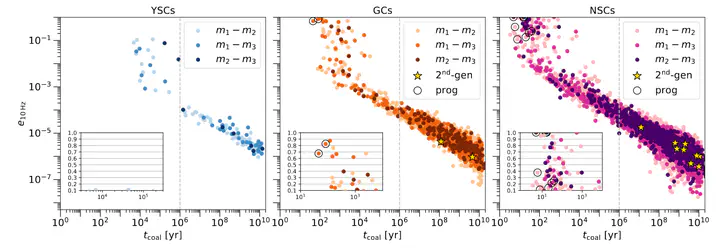Eccentric black hole mergers via three-body interactions in young, globular, and nuclear star clusters

Abstract
Eccentric mergers are a signature of the dynamical formation channel of binary black holes (BBHs) in dense stellar environments and hierarchical triple systems. Here, we investigate the formation of eccentric mergers via binary-single interactions by means of 2.5 × 10^5 direct N-body simulations. Our simulations include post-Newtonian terms up to the 2.5th order and model the typical environment of young (YSCs), globular (GCs), and nuclear star clusters (NSCs). Around 0.6% (1%) of our mergers in NSCs (GCs) have an eccentricity > 0.1 when the emitted gravitational wave frequency is 10 Hz in the source frame, while in YSCs this fraction rises to 1.6%. Approximately ∼63% of these mergers are produced by chaotic, resonant interactions where temporary binaries are continuously formed and destroyed, while ∼31% arise from an almost direct collision of two black holes (BHs). Lastly, ∼6% of these eccentric mergers occur in temporary hierarchical triples. We find that binaries undergoing a flyby generally develop smaller tilt angles with respect to exchanges. This result challenges the idea that perfectly isotropic spin orientations are produced by dynamics. The environment dramatically affects BH retention 0%, 3.1%, and 19.9% of all the remnant BHs remain in YSCs, GCs, and NSCs, respectively. The fraction of massive BHs also depends on the host cluster properties, with pair-instability (60 ≤ MBH/M⊙ ≤ 100) and intermediate-mass (M_BH ≥ 100 M⊙) BHs accounting for approximately ∼44% and 1.6% of the mergers in YSCs, ∼33% and 0.7% in GCs, and ∼28% and 0.4% in NSCs, respectively.